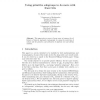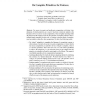7 search results - page 1 / 2 » Using Primitive Subgroups to Do More with Fewer Bits |
16
Voted
ANTS
2004
Springer
13 years 8 months ago
2004
Springer
Abstract. This paper gives a survey of some ways to improve the efficiency of discrete log-based cryptography by using the restriction of scalars and the geometry and arithmetic of...
ASIACRYPT
1999
Springer
13 years 9 months ago
1999
Springer
We present a variant of the Diffie-Hellman scheme in which the number of bits exchanged is one third of what is used in the classical Diffie-Hellman scheme, while the offered secu...
BIOINFORMATICS
2010
13 years 5 months ago
2010
Phylogenetic trees are widely used to display estimates of how groups of species evolved. Each phylogenetic tree can be seen as a collection of clusters, subgroups of the species ...
TCC
2010
Springer
14 years 1 months ago
2010
Springer
Abstract. For secure two-party and multi-party computation with abort, classification of which primitives are complete has been extensively studied in the literature. However, for...
JSYML
2010
13 years 3 months ago
2010
By taking a closer look at the construction of an Ackermann function we see that between any primitive recursive degree and its Ackermann modification there is a dense chain of p...


